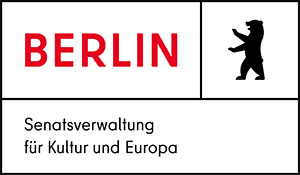1 September 2016–31 October 2017
Artists
Katrin Glanz, Various & Gould, Laura Horelli, Claude Gomis und Saskia Köbschall, Anna Kowalska, Diana Lucas-Drogan, Ellen Nonnenmacher und Eva Randelzhofer, Elizabeth Wood
Project group Kunst im Untergrund
Jochen Becker, Anna Gogonjan, Eva Hertzsch, Karin Kasböck, Folke Köbberling, Adam Page, Valeska Peschke
The large Hellersdorf housing estates were originally planned as a modern Garden City. Now in 2017, they overlook the venue of the International Garden Exhibition Berlin (IGA), opening mid April. Decisions made in Council offices in the city centre have led to a major infrastructural project „in the sticks“ whose legitmacy is questionable for many residents. The Kienberg Hill, officially protected land, has been fenced off and turned into a huge IGA building site since 2014, causing much local protest. Additionally residents fear significant rises in rental prices caused by the marketing of the area which comes with such an event.
Place Internationale and a victory column
The art competition’s central location in 2017 is an expansive piece of open green land interlaced with informal paths trodden by residents opposite Cottbusser Platz Underground Station, in visible proximity to the IGA. The organisers have named the land Place Internationale and, along with the selected artists, they will use this piece of land to make visible current universal contradictions and to create a place where they can be openly negotiated.
“Place Internationale” is a direct reference to the renaming of Place Vendôme in „Place Internationale“ on the occasion of the toppling of Napolean’s victory column on the square by Gustave Courbet and the Communards in Paris on 16th May 1871. Courbet organised a democratic vote on the future of the column and laid out manure and hay to soften its fall. Paris underwent a revolution of the city.
Hellersdorf’s „Place Internationale“ will be marked with an artistic reconstruction of the column and will function as a public location for collaborations with local partners. The column will be erected and toppled at events during “The Middle in Nowhere”.
Local young people from the Jugendclub U5 and the Melanchthon School have been working on the design of the column reconstruction since September 2016 with artists from the organisational team and the artists Ulrike Dornis, Martin Eggenfellner, Katja Renner, Zuzanna Skiba und Ole Tietjen. In a series of artistic workshops called “Participation and Governance“ they have looked at Gustave Courbet, the Communards, revolution, the individual, the State and the community. They have developed a colour concept for the column’s pedestal using the many nuances of human skin colour and a photographic concept for the pictorial stories on the column featuring themselves in political reenactments.
Project space station urbaner kulturen
Since 2014 the station urbaner kulturen has been a place for planing, research and reflection, for production and presentation, for discussions and interventions. It is homebase, adress, meeting point and venue for the Art in the Underground project and beyond.
The international open art competition Mitte in der Pampa [The Middle in Nowhere]
Eight artworks will be realised along the U5 and U55 lines, mainly on the Hellersdorf housing estate in the outskirts:
Katrin Glanz: Hellersdorfer Tanzplatz
›Place Internationale, near Cottbusser Platz (U5)
May - October 2017
Dance brings people together, opens hearts and crosses language barriers – and although still practiced at village fêtes, fewer and fewer people dance in public space today. During summer 2017 the artist Katrin Glanz is inviting residents and visitors to public dance sessions in Hellersdorf. On three Sundays, different locations will be transformed into places to celebrate internationality through folk dancing from various European countries – in circle, chain and paired dances. Other international dances are also welcome, the project being conceived to adapt to the wishes of its participants. The dancer Andrea Hartung will set the rhythm and musicians will play on traditional instruments like the diatonic accordeon, the bombarde, the cello and the guitar.
The first open-air dance floor will be on the green land opposite the refugee home on Maxi-Wander-Straße. The second will be on the small hill marking Hellersdorf’s original settlement at Cottbusser Platz Underground Station. The third will be on the central square on Kastanienboulevard, a pedestrian area currently undergoing planning consultation.
The »Hellersdorfer Tanzplatz« project seeks to get people out of their living rooms and connect various cultural backgrounds. It is about the pleasures of dance and communication, about making music tangible for everyone and initiating collaborations.
Various & Gould: City Skins – Marx und Engels
›Marx-Engels-Forum, near Alexanderplatz (U5)
›Place Internationale, near Cottbusser Platz (U5)
April - June 2017
»City Skins – Marx und Engels« by the artist team Various & Gould explores how society and municipal politics deal with monuments today. The artists will produce a full size cast of the Marx and Engels Monument near Berlin’s city hall made from screen printed papier mâché. In doing so, they use Ludwig Engelhardt’s bronze figures from 1986 exemplarily to set a discussion ‘in motion’ about symbolism in public space, urban planning and the proportionality of centre and periphery. The sculptural paper cast was completed on 1st May, then transported from the centre of Berlin to its outskirts and will be installed from 20th to 28th May on Place Internationale, the green land at Cottbusser Platz Underground Station in Berlin-Hellersdorf.
Laura Horelli: Namibia Today
›Underground Station U5 Schillingstraße (U5)
February - October 2017
The SWAPO (South West Africa People’s Organisation) Liberation Movement fought for Namibia’s independence from South Africa from 1960 to 1990 and has governed the country since 1990. In a series of billboards, the artist Laura Horelli pays special attention to the period between 1980 and 1985 when the English-language journal “Namibia Today” was printed by “Druckerei Fortschritt” in Erfurt in the former GDR. Its editorial board was based in exile in Luanda in Angola.
The artist has produced 18 billboards inspired by the journal. The posters have been partly printed by “Fortschritt”’s successor, “Druckhaus Gera”. The posters each combine a front page from “Namibia Today” with collaged material about the journal’s history in the GDR. Since the journal remains largely unresearched, a number of the images are brought together associatively.
The posters are presented in Schillingstraße Underground Station on the U5 line. The line is located in former East Berlin and is currently being extended into the ‘West’. Here the artist recalls the complexity of the solidarity movements and policies in the GDR. The title “Namibia Today” also evokes further associations that recall the colonial history of German South-West Africa (1884–1915) as well as the ongoing negotiations about the German genocide of the Herero and Nama peoples (1904–08). What is Namibia today – seen from current perspectives regarding the past?
Claude Gomis & Saskia Köbschall: Laboratorium der Solidarität
›Underground Station Kaulsdorf-Nord (U5)
October 2016 - October 2017
The project Laboratorium der Solidarität explores past and present methods of solidaritywith the fight against racialized forms of oppression. It takes Marzahn-Hellersdorf residents’ memories of former GDR solidarity movements (e.g. with the Civil Rights and Anti-Apartheid movements and the people of Vietnam) as its starting point. While the GDR placed great emphasis on the importance of a worldwide anti-racist struggle and education, it systematically denied the existence of racism “at home”. The project aims to emphasize the importance of self-reflective and critical methods of solidarity in the framework of Marzahn-Hellersdorf’s changing political, visual and discursive landscape. In this way the particularities of the borough’s specific history and current socio-cultural contexts might generate new forms of coexistence relevant beyond its boundaries.
Images found during the research will be installed on a footbridge above the Kaulsdorf-Nord Underground Station (U5).
Anna Kowalska: Endlich zuhause?
›station urbaner kulturen and neighbourhood
December 2016 - October 2017
The architect Lucien Kroll’s competition proposal from 1994 to rehumanise the Alte Hellersdorferstraße Plattenbau estate is Anna Kowalska’s point of reference for “Endlich zu Hause?”. Rather than demolish buildings on the Hellersdorf estate, Kroll’s idea was to reduce them in phases from 1994 to 2019, redesign the flats to be flexible and transform the yards into communicative places. Only isolated decorative elements have been implemented on the estate, meaning the sole remaining testamonies of the proposal are a few official documents and a book by Kroll in French. Kroll’s essential idea of „incrementalism“ – of a gradual, respectful change in living conditions in consultation with residents – was never implemented.
According to Kroll, paths are a fundamental element in the formation of a city. The architect designed a coloured scheme of paths, each with its own function, including a central, red path inspired by foot prints in snow made by residents taking habitual short cuts. This path should have continued to be worn to this day. Now the artist Anna Kowalska has recreated it on the estate as a red line. Another of Kroll’s proposed paths led to Kastanienboulevard, a pedestrian zone currently central to a council redevelopment scheme with resident consultation.
Diana Lucas-Drogan: Die Haut von Hellersdorf
›station urbaner kulturen and neighbourhood
October 2016-October 2017
“Die Haut von Hellersdorf” is a year-long artistic research about the relationship of residents, initiatives and students
in Hellersdorf to their physical environment. One main focus is how refugees appropriate some spaces and how they are excluded from others.
At the beginning of a multi-layered process, the knowledge accumulated from conversations and walks within Hellersdorf was artistically and scientifically reworked with students from the local Alice Salomon Hochschule. The results were exhibited in the station urbaner kulturen in February.
The artist then developed a series of complex Counter-Mappings based on spacial experiences in Hellersdorf. She transferred these alternative, community-derived maps onto plastic fabric which she then tailored into clothes.
On three evenings in September performers will wear these clothes like a second skin (with reference to the project’s title “Die Haut..”, engl. skin) at various places in Hellersdorf where the experiences and narratives originally began.
Ellen Nonnenmacher & Eva Randelzhofer: Wildwuchs & Ordnung
›Public spaces along the U5
April - October 2017
The artists will seek to initiate processes of micro-redistribution through various activities in public space, thereby raising questions about property, empowerment and our relationship to nature. The neighbourhood around Kastanienboulevard will be invited to transform an empty kiosk into a workshop for the production of individually made „Plant containers To Go“ from textile bags and fluid concrete. Seeds from the IGA 2017 (international garden exhibition) will be collected and planted in for the containers.
During collective happenings, the plant containers will be set up at places along the U5 line where nature has recently been destroyed by building projects. The containers create a sculptural marker which stands for collective, bottom-up urban planning. In turn, passers-by can themselves take apart and redistribute the marker. By also planting their seeds at places which have not yet been built upon, the artists will support the further growth and spread of wild vegetation.
Elizabeth Wood: A Migrant’s Journey
›Underground station Cottbusser Platz (U5), Platform
18 September 2016 - 8 October 2017
A Migrant’s Journey is an adaption of the cycle of poems “Die Winterreise”, written by Wilhelm Müller in 1823/24 and set to music by Franz Schubert in 1827/28. The poems tell of a lonely young man who leaves his village in search of peace–a peace he does not find. Elizabeth Wood has chosen certain lines which create a narrative and which might represent a migrant’s experience today in places like Hellersdorf, where there has been visible and tangible hostility. The text, layouted on a decorative background in a typeface suggesting traditional German, will be installed on the inside of the windows of the station staff room on the platform at Underground station Cottbusser Platz. The print is on transparent acrylic film allowing light to pass through from the inside of the staff room similar to light passing through stained glass.
Financed by

Supported by




In cooperation with

